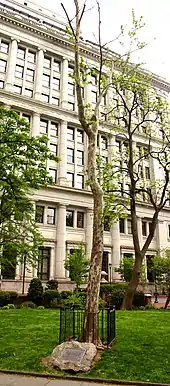Washington Square | |
 Washington Square in 2018 | |
   | |
| Location | between Walnut and 6th Sts., West and South Washington Square Philadelphia, Pennsylvania |
|---|---|
| Coordinates | 39°56′48.68″N 75°9′9.51″W / 39.9468556°N 75.1526417°W |
| Area | 6.4 acres (2.6 ha) |
| Built | 1683 |
| Architect | Thomas Holme G. Edwin Brumbaugh |
| MPS | Four Public Squares of Philadelphia TR |
| NRHP reference No. | 81000558[1] |
| Added to NRHP | September 14, 1981 |
Washington Square, originally designated in 1682 as Southeast Square, is a 6.4 acres (2.6 ha) open-space park in Center City, Philadelphia, The southeast quadrant and one of the five original planned squares laid out on the city grid by William Penn's surveyor, Thomas Holme. It is part of both the Washington Square West and Society Hill neighborhoods. In 2005, the National Park Service took over ownership and management of Washington Square, through an easement from the City of Philadelphia. It is now part of Independence National Historical Park.
History

By the early 18th century the square started being used as a burial ground.[2] Originally divided into triangles by two creeks, the northwestern portion was the potter's field, and the southeastern section was for the burial of Catholics.[3] The joining of the creeks created a fishing pond, and the grounds were commonly used for grazing by neighbors' cows.
In 1776, it became the final resting place for Washington's fallen soldiers. Long mass grave trenches the width of the square were first dug along 7th and Walnut Streets, and were eventually expanded to the South side. And during the British occupation of Philadelphia in 1777, the dead from the neighboring Walnut Street Jail were also interred here. Many victims of the city's yellow fever epidemic of 1793 were interred here, and the square was also used for cattle markets and camp meetings.
The square was closed as a cemetery, and improvement efforts began in 1815, as the neighborhoods around the square were developed and became fashionable. In 1825, the park was named Washington Square in tribute to George Washington and a monument to Washington was proposed. This monument was never built but served as the seed for the eventual tribute to soldiers of the Revolutionary War.
The periphery of Washington Square included an area called Lawyer's Row at 6th and Walnut, on the site of the former Walnut Street Prison. Around the square was also home to the city's publishing industry, including the Curtis Publishing Company, J. B. Lippincott, W. B. Saunders, Lea & Febiger, the Farm Journal, and George T. Bisel Co., law publishers, now the sole remaining publishing house on the square, with Franklin Jon Zuch serving as president since 1992. It has been located there since 1876 and still owned by the Bisel family.[2]
American Civil War
Initially, the square contained monuments to those who had fought in the American Civil War. One such monument was the Washington Grays Monument. In 1954, the decision was made to remove the civil war commemorations and focus the square solely on the memory of the American Revolutionary War.[4]
Tomb of the Unknown Revolutionary War Soldier
In 1954, the Washington Square Planning Committee decided that, instead of the original proposed monument to Washington, a monument to all soldiers and sailors of the Revolutionary War would be built.[5] The monument, designated the "Tomb of the Unknown Revolutionary War Soldier", was designed by architect G. Edwin Brumbaugh and includes a bronze cast of Houdon's statue of Washington as the monument's centerpiece. The Tomb includes remains which were disinterred, after archeological examination, from within the park from when it was a cemetery. The remains are that of a soldier, but it is uncertain if he was Colonial or British.[5] An unknown number of bodies remain buried beneath the square and the surrounding area; some are still occasionally found during construction and maintenance projects.
Moon Tree

A sycamore Moon tree in the square, planted in 1975, was grown from seeds that had been carried to the Moon by astronaut Stuart Roosa on the Apollo 14 mission.[6] The Moon tree died in 2009 and was replaced with a clone in 2011, which had also died as of November 2019, leaving the plaque about the Moon tree in place.[7]
In popular culture
The pop-punk group The Wonder Years wrote about Washington Square in their song "Washington Square Park", from their album The Upsides.
See also
References
Notes
- ↑ "National Register Information System". National Register of Historic Places. National Park Service. January 23, 2007.
- 1 2 UShistory.org page on Washington Square
- ↑ Kirlin, Joseph L. J. (1909). Catholicity in Philadelphia From the Earliest Missionaries Down to the Present Time. Philadelphia: John Jos. McVey. pp. 87–88.
- ↑ "Landscapes of 'recaptured' monuments: the Washington Grays Monument pedestal – The Necessity for Ruins".
- 1 2 "Tomb of the Unknown Revolutionary Soldier" on USHistory.org
- ↑ NASA article on Bicentenntial Moon Tree
- ↑ Atlas Obscura
External links
- Washington Square - Independence National Park, National Park Service
- Philadelphia.gov website


